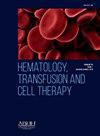PREDİCTİON OF THE RİSK OF LEUKEMİA DEVELOPMENT İN AGED HEALTHY POPULATİON: IMPLEMENTATİON İN THE PUBLİC HEALTH SYSTEM
IF 1.6
Q3 HEMATOLOGY
引用次数: 0
Abstract
In the last 10-years, several scientific reports have provided evidence of the accumulation of somatic mutations in Hematopoietic Stem and Progenitor Cells (HSPC) in subjects aged > 50yrs. This phenomenon is defined as Clonal Hematopoiesis of Indeterminate Potential (CHIP). As discovered and developed by Abelson et.al. (Nature. 2018) these mutations are detectable many years before the clinical onset of Acute Myeloid Leukemia (AML) and are potentially linked to its subsequent evolution. It is important to underline that the correlation between mutations and the development of AML does not represent an early diagnosis but only an increased risk of developing AML. The risk depends on many factors: type of mutations, how many cells carry the mutation, and combination of mutations. A risk score has been established (NEJM 2023); according to this study few subjects with CHIP are going to develop AML. Of note: the studies that document these correlations were retrospective. It might be relevant to emphasize that “early diagnosis of AML” does not seem to have, given the dynamics of cellular proliferation, concrete advantages. The identification early in advances of a constellation of mutations and their combinations possibly associated with the risk of developing AML could instead be very effective, if there were drugs targeting specific mutations. From a precision, personalized and participatory medicine perspective, these studies have led us to launch a prospective project on a healthy population of individuals between 50 and 80-years old. We reasoned that this type of screenings based on complex landscapes of genetic mutations will become more and more present in the evolving scenario of predictive medicine. Thus, the company Dedalus Italia S.p.A. designed the model and the software for implementing these screening studies in the Health Services. The project’ name is “SInISA”*. The experimentation is carried out in the territory of the Regional-Health-Service (ASL5) of Eastern Liguria (Italy), with the aim of verifying and evaluating both the organizational model and the technological infrastructure to support it, with the ambition of initially sequencing the DNA with a panel of about 90 genes. The first step was to identify subjects with higher probability of bearing mutations. The first screening element will be the RDW parameter. Subjects with RDW > 15 have higher probability of bearing mutations in blood cells. It was calculated that to identify individuals with RDW > 15 it is necessary start from a population of approx. 12000 subjects This study is based on the free and voluntary participation of citizens. Therefore, this approach opens the doors to the so-called “participatory medicine” which is, and will be, an essential element for the development of these new paths for the management of citizens' health. The objectives are therefore: 1) To verify the correlation of RDW > 15 and presence of mutation in a prospective study; 2) To define an organizational model that can be the basis of future screening processes, in the adult/elderly population; 3) To design and implement an integrated technological platform capable of supporting the screening campaign, managing the information and process peculiarities of genetic studies, automating the identification of the target, the sequence of controls and the interactions with the sequencing structures, activating in a logic of continuity of care and follow-up pathways. * “SInISA” is funded under the POR-FESR Liguria 2021‒2027 Action 1.1.1 and is carried out by Dedalus Italia S.p.A., lead company, Leonardo S.p.A, Genartis S.r.l., Rulex Innovation Labs S.r.l., CherryChain S.r.l., VIS S.r.l., University of Genoa with Department of Experimental Medicine and the SRV Center”.
Predİctİon的rİsk的leukemİa的发展İn老年健康的populatİon: implementatİon İn的publİc卫生系统
在过去的10年里,一些科学报告已经提供了证据,证明在老年受试者中造血干细胞和祖细胞(HSPC)的体细胞突变积累。50岁。这种现象被定义为不确定电位克隆造血(CHIP)。由Abelson等人发现和发展。(Nature. 2018)这些突变在急性髓性白血病(AML)临床发病多年前就可以检测到,并且可能与其随后的进化有关。需要强调的是,突变与AML发展之间的相关性并不代表早期诊断,而只是增加了发展为AML的风险。风险取决于许多因素:突变的类型,携带突变的细胞数量,以及突变的组合。建立了风险评分(NEJM 2023);根据这项研究,CHIP患者很少会发展为AML。值得注意的是,记录这些相关性的研究是回顾性的。可能需要强调的是,考虑到细胞增殖的动态,“AML的早期诊断”似乎没有具体的优势。如果有针对特定突变的药物,早期识别可能与发生AML风险相关的一系列突变及其组合可能是非常有效的。从精确、个性化和参与性医学的角度来看,这些研究使我们启动了一项针对50至80岁健康人群的前瞻性项目。我们推断,这种基于复杂基因突变的筛查将越来越多地出现在预测医学的发展场景中。因此,Dedalus Italia S.p.A.公司设计了模型和软件,以便在卫生服务部门实施这些筛查研究。项目名称为“SInISA”*。试验是在东利古里亚(意大利)地区卫生局(ASL5)境内进行的,目的是验证和评估组织模式和支持该模式的技术基础设施,其目标是首先用大约90个基因组成的小组对DNA进行测序。第一步是确定携带突变的可能性较高的受试者。第一个筛选元素将是RDW参数。RDW >受试者;15人的血细胞突变几率更高。计算出,为了识别RDW >;有必要从大约的人口开始。本研究基于公民自由自愿参与。因此,这种做法为所谓的“参与式医疗”打开了大门,这是而且将是发展这些管理公民健康的新途径的基本要素。因此,我们的目标是:1)验证RDW和gt的相关性;15和在前瞻性研究中存在突变;2)定义一个组织模型,可以作为未来成人/老年人筛查过程的基础;3)设计和实施一个集成的技术平台,能够支持筛选活动,管理遗传研究的信息和过程特性,自动识别靶标,控制序列和与测序结构的相互作用,以连续的护理和后续途径的逻辑激活。*“SInISA”由POR-FESR利古利亚2021-2027行动1.1.1资助,由牵头公司Dedalus Italia S.p.A、Leonardo S.p.A、Genartis S.r.l、Rulex Innovation Labs S.r.l、CherryChain S.r.l、VIS S.r.l、热那亚大学实验医学科和SRV中心共同实施。
本文章由计算机程序翻译,如有差异,请以英文原文为准。
求助全文
约1分钟内获得全文
求助全文
来源期刊

Hematology, Transfusion and Cell Therapy
Multiple-
CiteScore
2.40
自引率
4.80%
发文量
1419
审稿时长
30 weeks
 求助内容:
求助内容: 应助结果提醒方式:
应助结果提醒方式:


